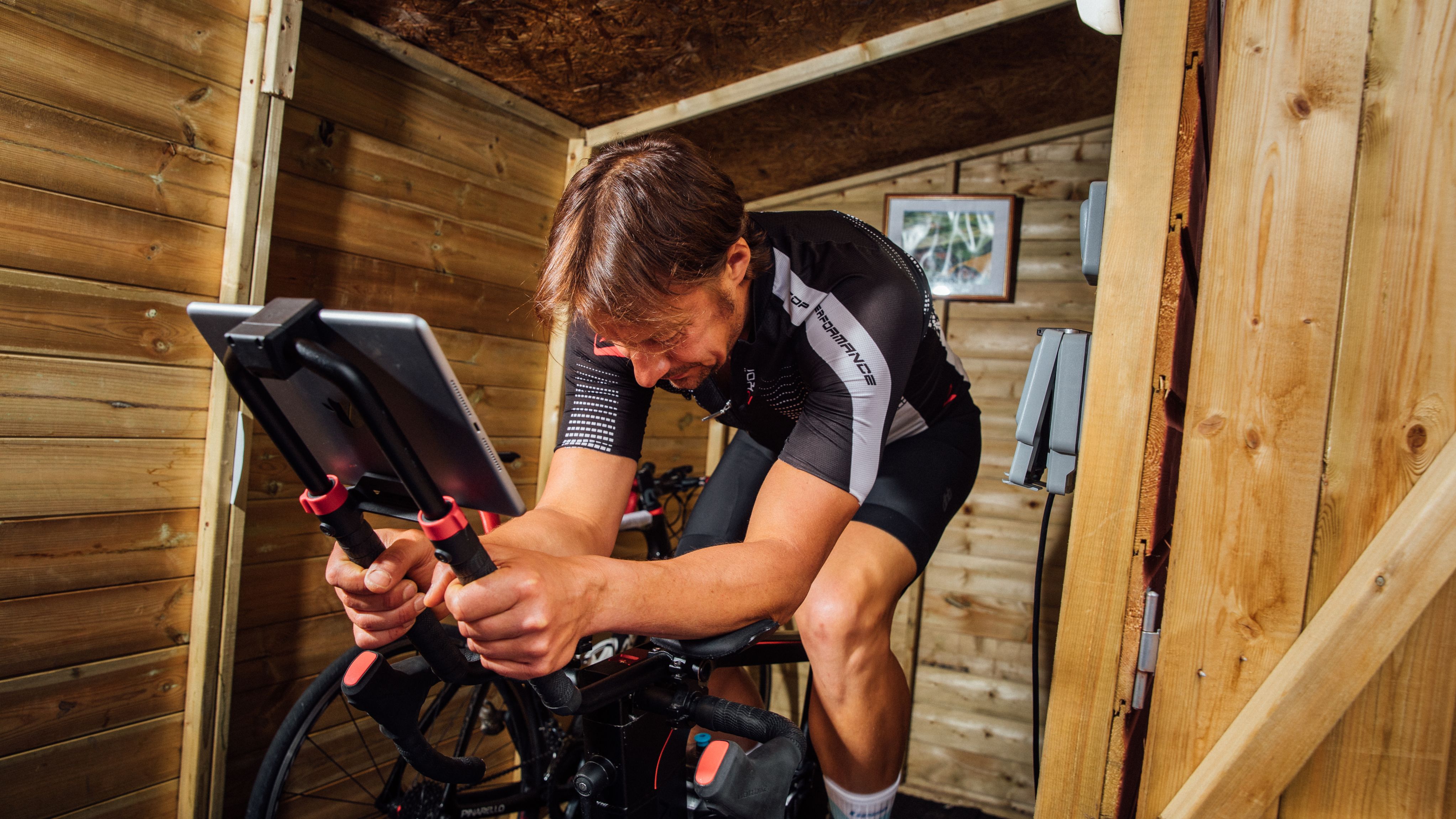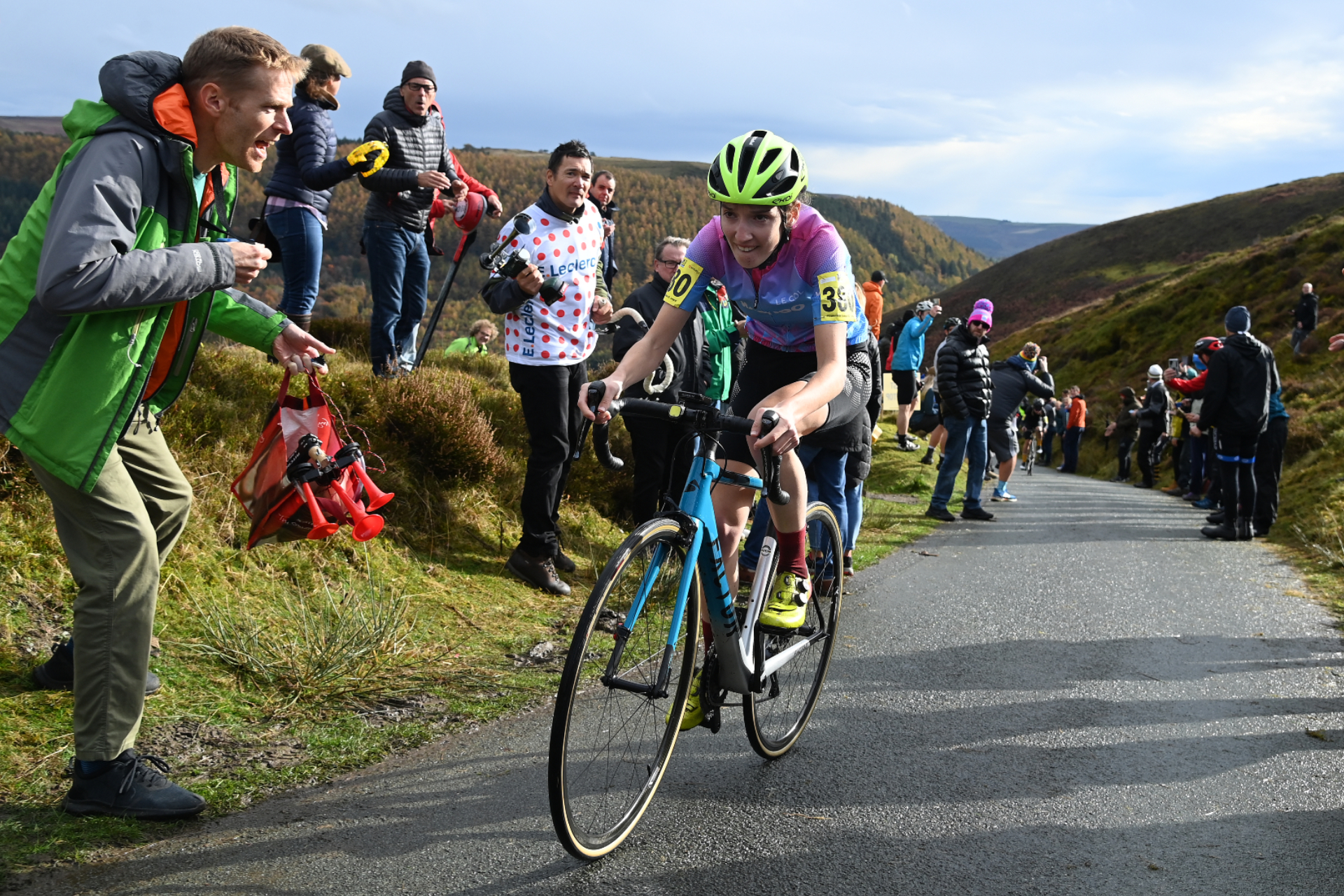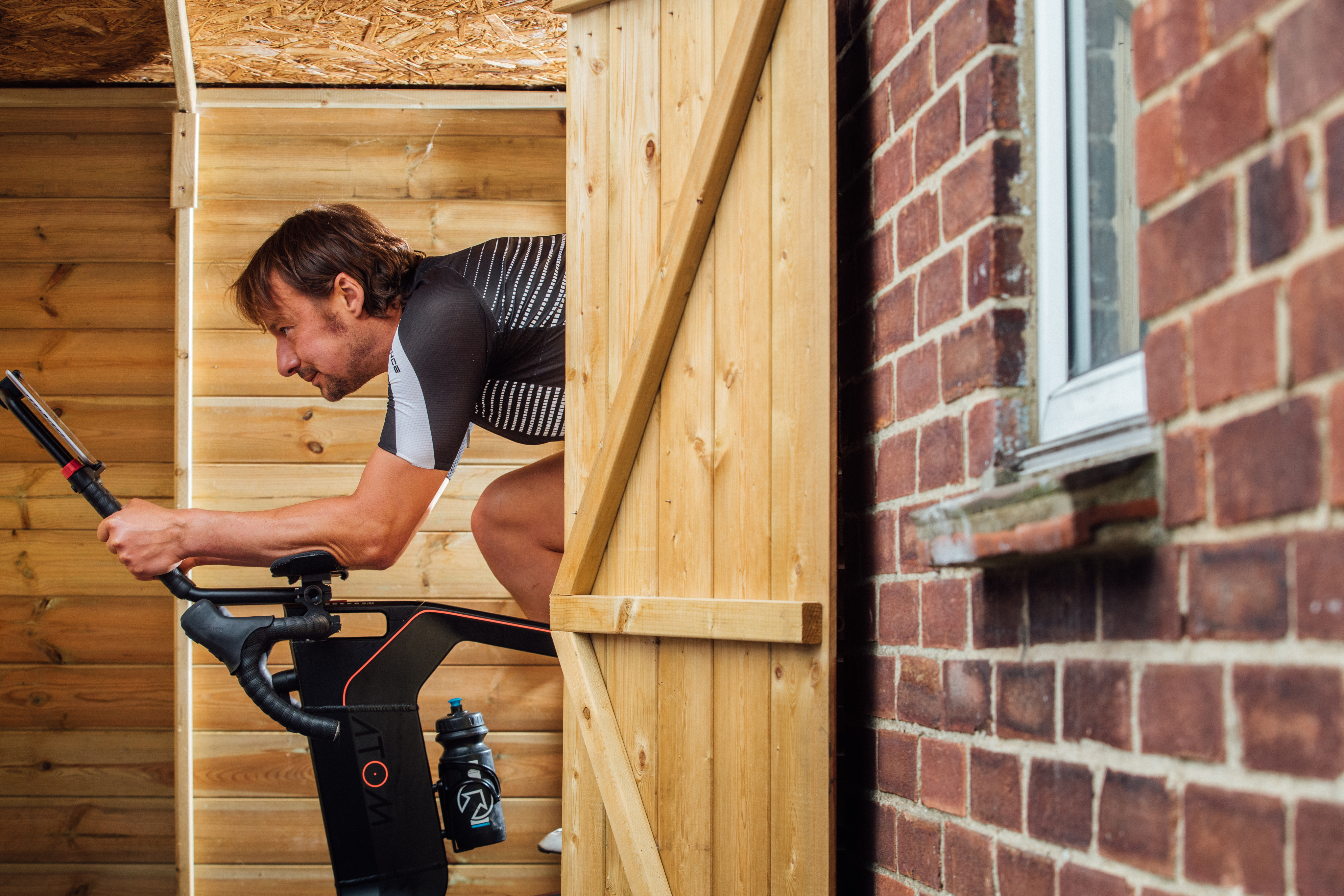
Wake up; spend 12 hours in a melancholic trance; go to bed. While this is fairly standard practice for a mid-winter’s day in the UK, I’d decided to add an extra layer of misery to December's blanket of gloom by taking on a Virtual Everesting attempt and riding the height of Everest (8,840metres), indoors. Why? Because for reasons I’m not quite yet able to fathom, cyclists seem to err towards making life as miserable as possible.
For some reason, we cyclists like to seek out activities that will elicit a maximum level of pain and discomfort. And when we’ve finished, maybe a week later when the chafing is subsidising, we look back and think ‘that was a really horrific experience – but not quite horrific enough. Let’s do another one.’
I was pretty sure that Virtual Everesting would put an end to this cycle. Having spoken to Virtual Everesting survivors, I was confident that this would be my swansong. My bicycles and turbo trainer would then spend the rest of their lives under a thick tarpaulin in the furthest reaches of my shed. Or, so I hoped.
Virtual Everesting, Hour by Hour
7:00: The light of the shed flickered on to reveal my steed – a shiny Wattbike Atom. I would become intimately acquainted with this piece of apparatus today. It would learn my darkest secrets and my deepest fears, it would also become saturated in various bodily fluids. Yes, this Wattbike and I were about to get to know each other very well indeed.
8:00: Halfway up my second ascent of the day and I’d already identified what could be a significant issue. Let’s just reiterate some of the finer points quickly: I’m in a shed, at 8am, in the middle of winter. Needless to say, it's cold. While the first ascent had warmed me up, the subsequent descent saw my body temperature drop as quickly as Alp du Zwift’s gradient. Homeostatic regulation had now been added to my little list of variables. I shut down the fan. And it stayed that way for the remainder of the ride.

Zwift’s Alpe du Zwift (the app’s version of the Tour de France classic, Alpe d’Huez) is easily the most Everested climb, so I decided to follow the masses. I thought long and hard about this: a 12km stretch of virtual asphalt that steadily rises at an average of around 8%. At Zone 2 it would take 70 minutes to crest and 12 or so minutes to descend – time I could use to stretch, eat and cry. Yes, logistically the Alp was unbeatable – eight and a half ascents and it’s goodbye cycling, hello hot Bovril in front of the box. However, after recceing the climb several days prior, it was hard to get past the length. The mountain began playing games with me before I’d even started. I decided that to give myself a psychological edge, I’d use hairpin seven – the famous Dutch Corner – as my summit point. This would now be spread over 14 laps at around 40 minutes in duration, and, to my mind, a great deal more surmountable.
9:00: I’d spent the first two hours looking for ‘the zone’. Unfortunately I hadn’t been able to locate it. In hindsight, I went after it too early. In order to really zone out there has to be a certain amount of physical and mental discomfort present, flames of adrenaline should have been reduced to cinders and the gargantuan task ahead should be acknowledged – not necessarily in your mind, but somewhere in your soul. Only then do you have the potential of stumbling on that out-of-body experience - the one where you forget you’re riding a bicycle, and deploy your pedalling autopilot. Yes, this had been shoddy workmanship. But significant in-roads were being made…
10:00: I’d arrived at the top of my fourth ascent and, despite not having found anything resembling the zone, was on course for a 12-hour virtual Everesting. I was also buoyed to the brink of jubilation to note I was over a quarter of the way to the eventual summit. However, the feeling in my feet was now a thing of the past – the remaining traces of sensation having completely vanished halfway down the third descent. Goodbye feet - I imagine I’ll hear from you again in the bath at some point this evening. And I imagine it will hurt, a lot.
11:00: I used the fifth descent to take the opportunity to make a well-earned change of bibshorts. I cracked open the shed door and the weather snarled at me to get back in. I had to risk it. Hobbling across the lawn, the wind landed thunderous blows and bitter slaps before I made it to the front door and staggered in. ‘How’s it going?,’ inquired my better half. I tried to tell her that it was going quite well but it appeared I’d lost the ability to speak. I simply rasped at her in gibberish. Perhaps it wasn’t going as well as I thought it was.

Before I began scaling Everest’s 8,840m however, I had shopping to do – so I dug out the biggest bag-for-life I could find and headed to the supermarket. My shopping list comprised of one single entry: sugar. Haribo, cupcakes, pain au chocolate, jumbo caramel stroopwafel, a tin of Cadbury Heroes – the cashier who rang the items through the till genuinely looked worried for my mental well-being. I wanted to explain to her that I was about to cycle up Mount Everest in my shed and needed sustenance for the journey but I don’t think that would’ve done anything to quell her concern.
12:00: It was about halfway up the sixth ascent of the day when the Zone 2 power I’d been tapping out for the last five hours began to dramatically ebb away. Gone were the days of 240 watts. The 190 watt era had arrived. I now lived on the planet Zone 1. It was quite nice here, with a relaxed atmosphere. Although the food wasn’t up to much.
13:00: The menu on Planet Zone 1 was a sparsely populated list. In fact it only had one item on it: sugar. I had spent the last six hours consuming vast quantities of the stuff. As per my shopping list it took on many forms and I was currently going through a stroopwafel phase, predominantly because I’d eaten everything else on the list. I wasn’t enjoying the stroopwafels. My entire being was telling me the next bite would result in projectile vomit. However, by this stage I’d burnt off close to 3,500 calories and eating these damn stroopwafels was the only way I’d be able to proceed – eating at this point was very much of the essence.
14:00: The eighth climb of the day saw me stray into podcast territory. Things were starting to bite both mentally and physically and while I’d had the occasional dalliance with ‘the zone’ I now needed external stimulation to help take the edge off what was turning into a survival situation. This helped tremendously. I found a true crime podcast detailing the lives of various villains and gangsters who’d gone from woe to thuggery to woe again and then just to being normal. If you want woe, I thought, try sitting on a Wattbike Atom for eight straight hours.
15:00: At 3pm I was still on course for a 12-hour virtual Everesting. Just. I’d managed 18,000ft of climbing over 85 miles. Another 10,000ft was mere piffle. I decided that a film should send me home. The longest I could find on Netflix was The Irishman starring Robert de Niro, Joe Pesci and Al Pacino. It’s three and half hours long. I minimised my Zwift window, put the movie on, and got the stroopwafel ready for an afternoon at the pictures.

Multiple time British National Hill Climb champion, Illi Gardner, completed her first Virtual Everesting in 9.5 hours averaging 4w/kg for the duration
“At the top of every climb or on every descent, I make sure to eat quite a lot. Doing hill-reps indoors means that you can take a good break on every descent and it makes a big difference to your fuelling strategy [compared to Everesting outside]. It’s a great way to break up the ride and acts as a reminder to eat. When you're out on the road, it's easy to forget or put it off. But when you have that kind of set break each lap, it's easier to make sure you eat. I basically eat solid food for as long as possible, stuff like cereal bars. Although towards the end I go for stuff high in sugar like Coke and gels.”
16:00: I’m not sure if it was the mollifying effect of De Niro’s dulcet tones or the fact that I’d been riding for over nine hours up and down a pretend mountain but I was now barely treading water. I was in that grey zone where you’re turning the pedals and the turbo trainer is just about able to muster a wattage reading. Yes, I’d been exiled from Planet Zone 1 and now lived in a place where dried up cyclists fester amid feeble power numbers.
17:00: With over 100 miles now on the clock and some 21,000ft of vertical gain to my name I happened upon an insurmountable hurdle: I was literally unable to eat any more food, stroopwafel or otherwise. My stomach had been mentioning in passing for the last three hours that it was unable to take much more of the sustained barrage of confectionery I’d been bombing it with, and now, in an act of sheer insolence it had completely shut down. I surreptitiously nibbled on the side of a stroopwafel and immediately threw it up. The mountain, it seemed, was winning.
18:00: My 11th hour on the mountain wasn’t pretty. I was so sapped of leg strength that I had to use my hands to force my thighs down to propel the pedals. This resulted in a cadence of about 10rpm and a wattage of around the same number. At this rate each ascent would’ve taken about four hours to complete. So with 22,900ft and 107 miles on the clock I clambered off my Wattbike Atom and limped towards the living room. There was a nice comfortable sofa with my name on it. I’d spend the rest of the evening watching something braindead on the box – and planning my next ride, of course.

Spending 11 and a half hours on a static bike taught me several valuable lessons, the first of which being I never want to do it again. However, if for some reason I did get the urge to have another go at Virtual Everesting I’d put a whole lot more focus into fuelling – after all, this was where I ultimately crashed and burned.
I expended over 7,000 calories during my attempt and, counting up the the packets strewn over the shed floor, it looks like I’d only eaten around a third of that. It was this calorie deficit that saw my power ebb to a level where continuing was not an option. So next time (and let’s face it – I’ve got unfinished business with the Alp) I’ll be spending more time eating a wider variety of food, both sweet and savoury, in a bid to keep my glycogen levels high and stave off the dreaded bonk.





!["[T]he First and Fifth Amendments Require ICE to Provide Information About the Whereabouts of a Detained Person"](https://images.inkl.com/s3/publisher/cover/212/reason-cover.png?w=600)

